Relationship: Job Satisfaction and Performance at Sompo Insurance HK
VerifiedAdded on 2021/04/17
|83
|18851
|67
Thesis and Dissertation
AI Summary
This dissertation investigates the relationship between employee job satisfaction and its impact on job performance, focusing on a case study of Sompo Insurance (Hong Kong) Co., Ltd. The research encompasses five chapters, beginning with an introduction that outlines the research rationale, aims, objectives, and research questions. The literature review provides a theoretical framework, exploring concepts such as Affect Theory, Discrepancy Theory, and Herzberg’s Two-Factor Theory. The methodology chapter details the research approach, including the use of positivism philosophy, an explanatory research design, and a deductive approach, utilizing both primary and secondary data collected through an email survey of 50 senior-level employees. Data analysis involved SPSS 2.0 software for correlation and regression analysis. The findings indicate a low level of job satisfaction among Sompo Insurance employees due to stress and performance management issues, including conflict management and limited growth opportunities. The study concludes with recommendations to improve work-life balance, performance management, quality of supervision, and employee engagement, along with limitations and suggestions for future research.
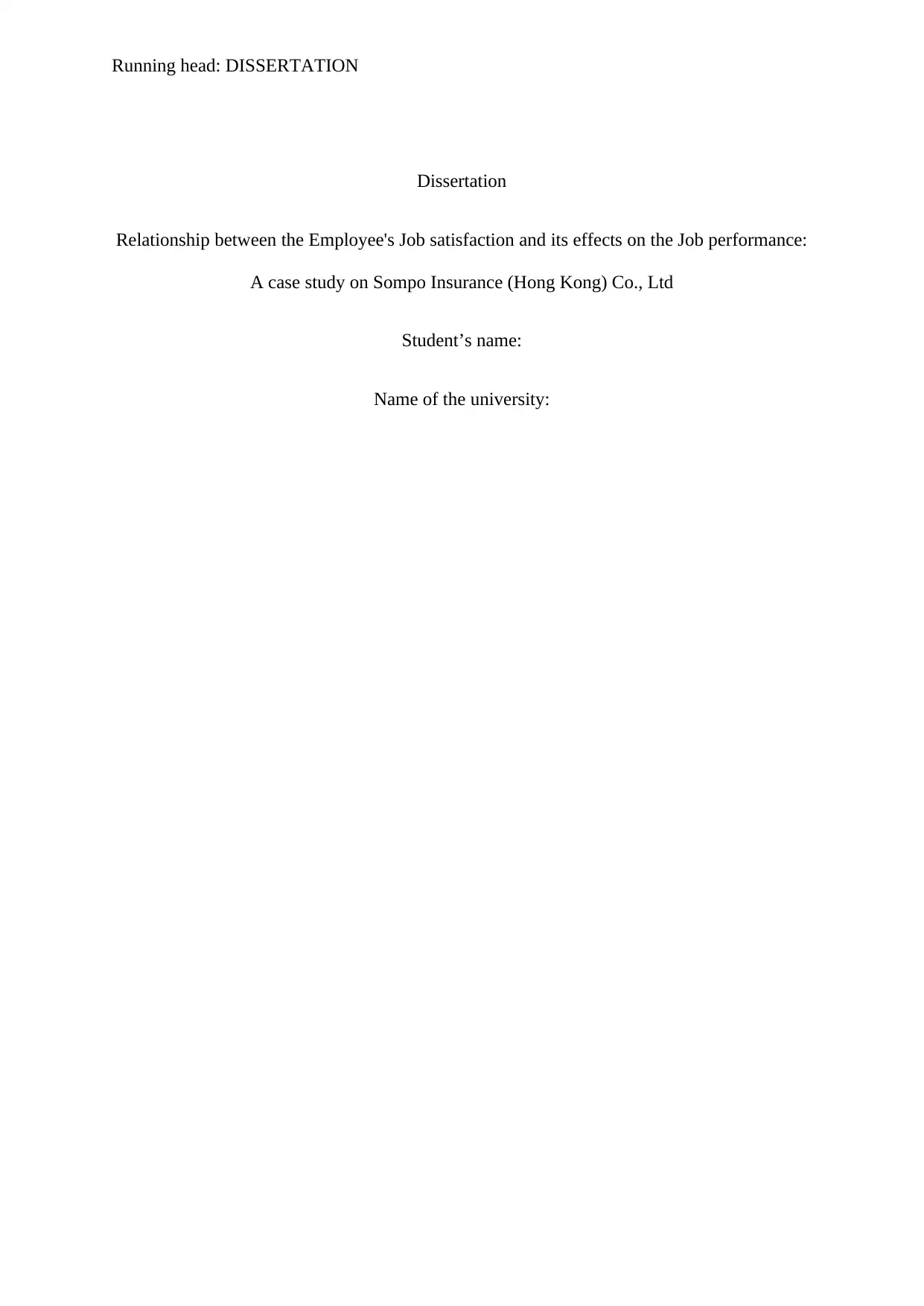
Running head: DISSERTATION
Dissertation
Relationship between the Employee's Job satisfaction and its effects on the Job performance:
A case study on Sompo Insurance (Hong Kong) Co., Ltd
Student’s name:
Name of the university:
Dissertation
Relationship between the Employee's Job satisfaction and its effects on the Job performance:
A case study on Sompo Insurance (Hong Kong) Co., Ltd
Student’s name:
Name of the university:
Paraphrase This Document
Need a fresh take? Get an instant paraphrase of this document with our AI Paraphraser
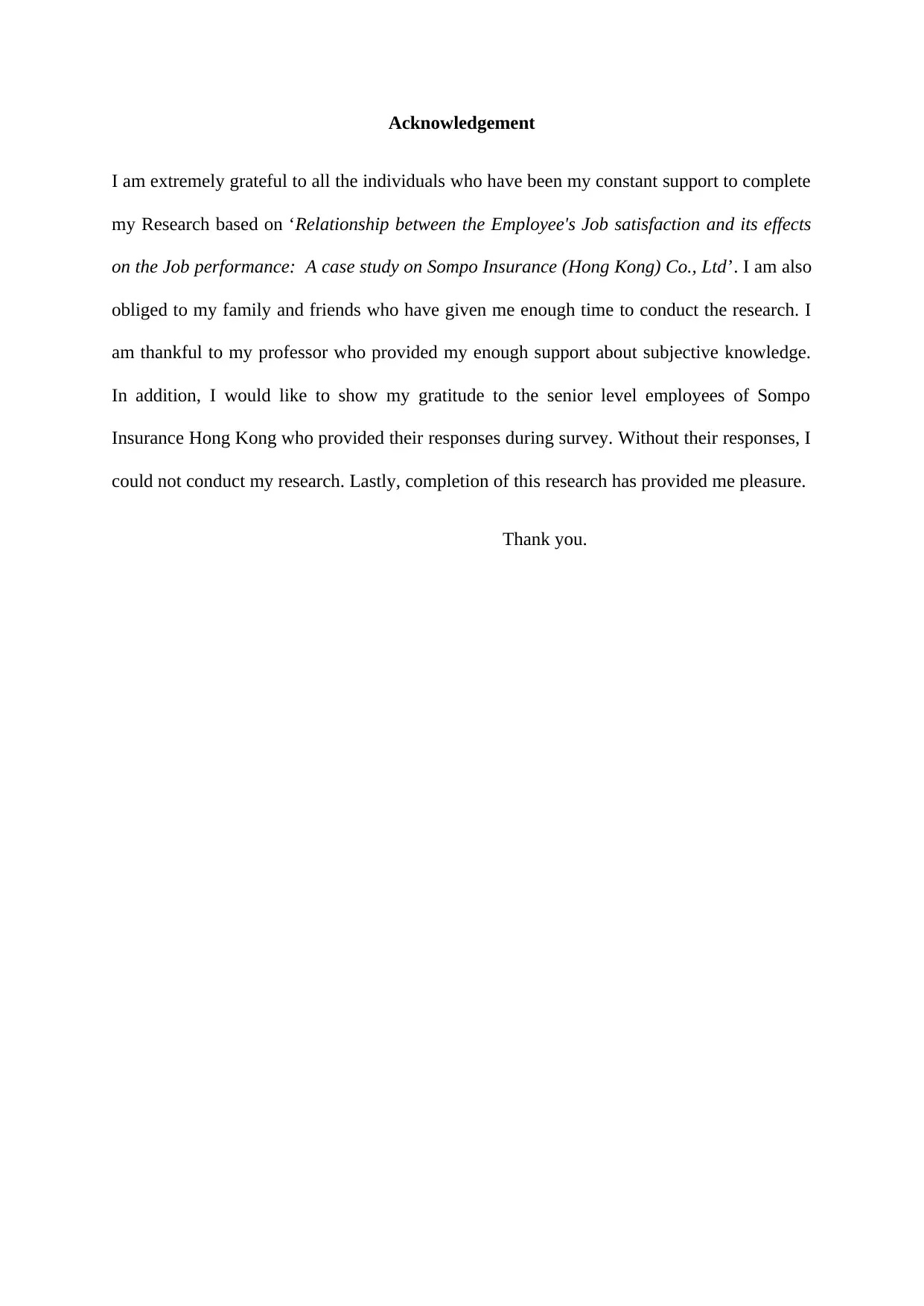
Acknowledgement
I am extremely grateful to all the individuals who have been my constant support to complete
my Research based on ‘Relationship between the Employee's Job satisfaction and its effects
on the Job performance: A case study on Sompo Insurance (Hong Kong) Co., Ltd’. I am also
obliged to my family and friends who have given me enough time to conduct the research. I
am thankful to my professor who provided my enough support about subjective knowledge.
In addition, I would like to show my gratitude to the senior level employees of Sompo
Insurance Hong Kong who provided their responses during survey. Without their responses, I
could not conduct my research. Lastly, completion of this research has provided me pleasure.
Thank you.
I am extremely grateful to all the individuals who have been my constant support to complete
my Research based on ‘Relationship between the Employee's Job satisfaction and its effects
on the Job performance: A case study on Sompo Insurance (Hong Kong) Co., Ltd’. I am also
obliged to my family and friends who have given me enough time to conduct the research. I
am thankful to my professor who provided my enough support about subjective knowledge.
In addition, I would like to show my gratitude to the senior level employees of Sompo
Insurance Hong Kong who provided their responses during survey. Without their responses, I
could not conduct my research. Lastly, completion of this research has provided me pleasure.
Thank you.
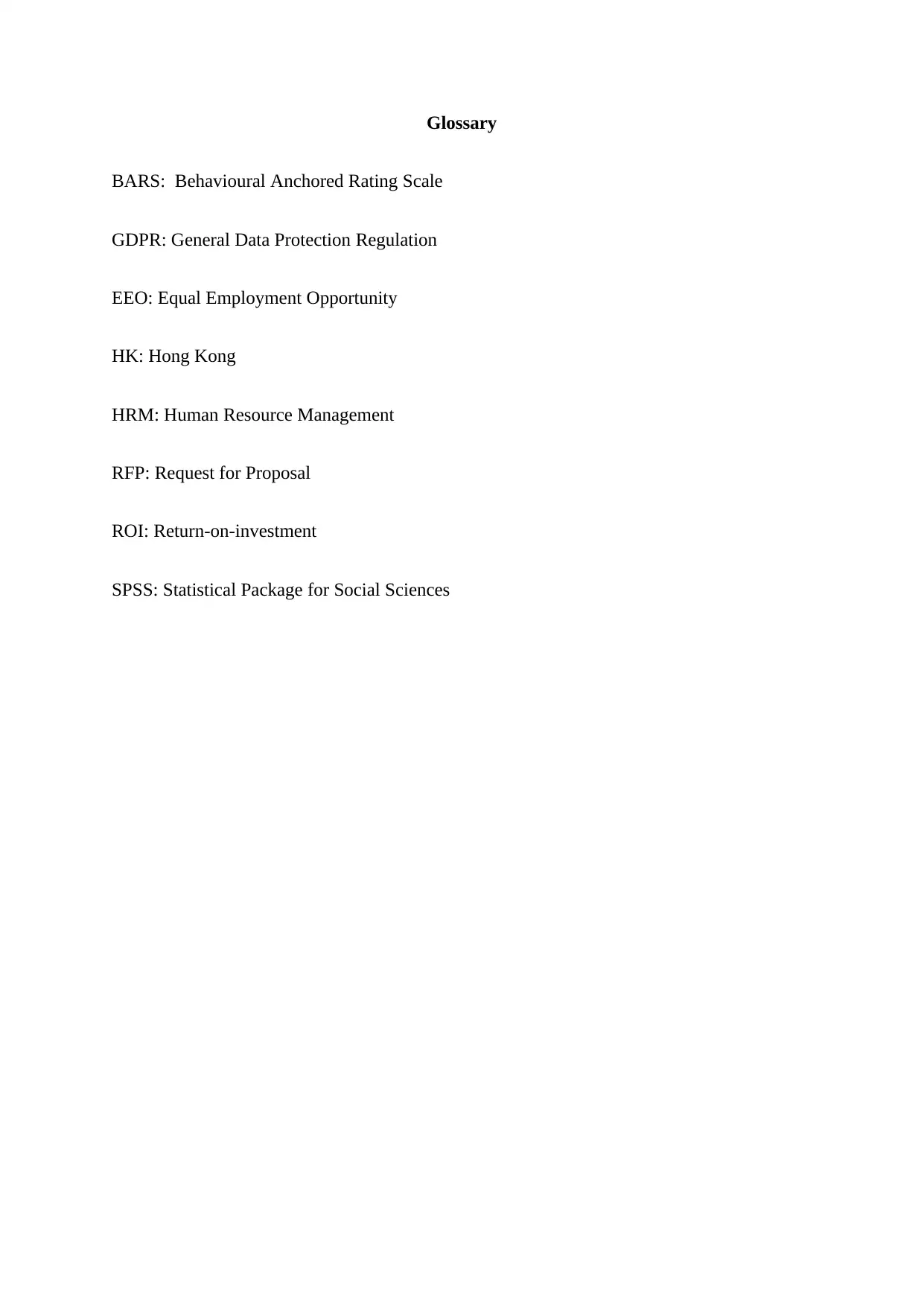
Glossary
BARS: Behavioural Anchored Rating Scale
GDPR: General Data Protection Regulation
EEO: Equal Employment Opportunity
HK: Hong Kong
HRM: Human Resource Management
RFP: Request for Proposal
ROI: Return-on-investment
SPSS: Statistical Package for Social Sciences
BARS: Behavioural Anchored Rating Scale
GDPR: General Data Protection Regulation
EEO: Equal Employment Opportunity
HK: Hong Kong
HRM: Human Resource Management
RFP: Request for Proposal
ROI: Return-on-investment
SPSS: Statistical Package for Social Sciences
⊘ This is a preview!⊘
Do you want full access?
Subscribe today to unlock all pages.

Trusted by 1+ million students worldwide
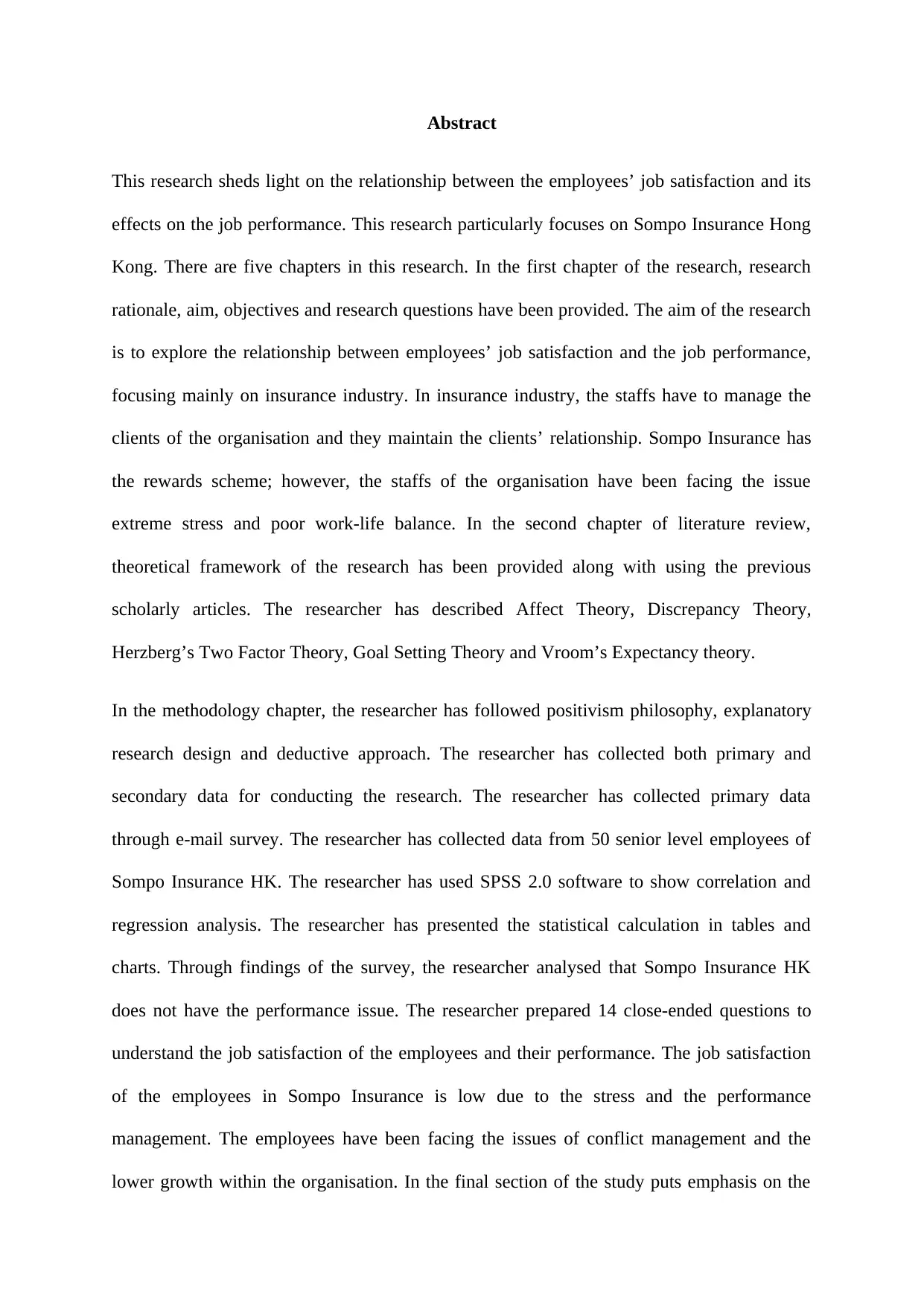
Abstract
This research sheds light on the relationship between the employees’ job satisfaction and its
effects on the job performance. This research particularly focuses on Sompo Insurance Hong
Kong. There are five chapters in this research. In the first chapter of the research, research
rationale, aim, objectives and research questions have been provided. The aim of the research
is to explore the relationship between employees’ job satisfaction and the job performance,
focusing mainly on insurance industry. In insurance industry, the staffs have to manage the
clients of the organisation and they maintain the clients’ relationship. Sompo Insurance has
the rewards scheme; however, the staffs of the organisation have been facing the issue
extreme stress and poor work-life balance. In the second chapter of literature review,
theoretical framework of the research has been provided along with using the previous
scholarly articles. The researcher has described Affect Theory, Discrepancy Theory,
Herzberg’s Two Factor Theory, Goal Setting Theory and Vroom’s Expectancy theory.
In the methodology chapter, the researcher has followed positivism philosophy, explanatory
research design and deductive approach. The researcher has collected both primary and
secondary data for conducting the research. The researcher has collected primary data
through e-mail survey. The researcher has collected data from 50 senior level employees of
Sompo Insurance HK. The researcher has used SPSS 2.0 software to show correlation and
regression analysis. The researcher has presented the statistical calculation in tables and
charts. Through findings of the survey, the researcher analysed that Sompo Insurance HK
does not have the performance issue. The researcher prepared 14 close-ended questions to
understand the job satisfaction of the employees and their performance. The job satisfaction
of the employees in Sompo Insurance is low due to the stress and the performance
management. The employees have been facing the issues of conflict management and the
lower growth within the organisation. In the final section of the study puts emphasis on the
This research sheds light on the relationship between the employees’ job satisfaction and its
effects on the job performance. This research particularly focuses on Sompo Insurance Hong
Kong. There are five chapters in this research. In the first chapter of the research, research
rationale, aim, objectives and research questions have been provided. The aim of the research
is to explore the relationship between employees’ job satisfaction and the job performance,
focusing mainly on insurance industry. In insurance industry, the staffs have to manage the
clients of the organisation and they maintain the clients’ relationship. Sompo Insurance has
the rewards scheme; however, the staffs of the organisation have been facing the issue
extreme stress and poor work-life balance. In the second chapter of literature review,
theoretical framework of the research has been provided along with using the previous
scholarly articles. The researcher has described Affect Theory, Discrepancy Theory,
Herzberg’s Two Factor Theory, Goal Setting Theory and Vroom’s Expectancy theory.
In the methodology chapter, the researcher has followed positivism philosophy, explanatory
research design and deductive approach. The researcher has collected both primary and
secondary data for conducting the research. The researcher has collected primary data
through e-mail survey. The researcher has collected data from 50 senior level employees of
Sompo Insurance HK. The researcher has used SPSS 2.0 software to show correlation and
regression analysis. The researcher has presented the statistical calculation in tables and
charts. Through findings of the survey, the researcher analysed that Sompo Insurance HK
does not have the performance issue. The researcher prepared 14 close-ended questions to
understand the job satisfaction of the employees and their performance. The job satisfaction
of the employees in Sompo Insurance is low due to the stress and the performance
management. The employees have been facing the issues of conflict management and the
lower growth within the organisation. In the final section of the study puts emphasis on the
Paraphrase This Document
Need a fresh take? Get an instant paraphrase of this document with our AI Paraphraser
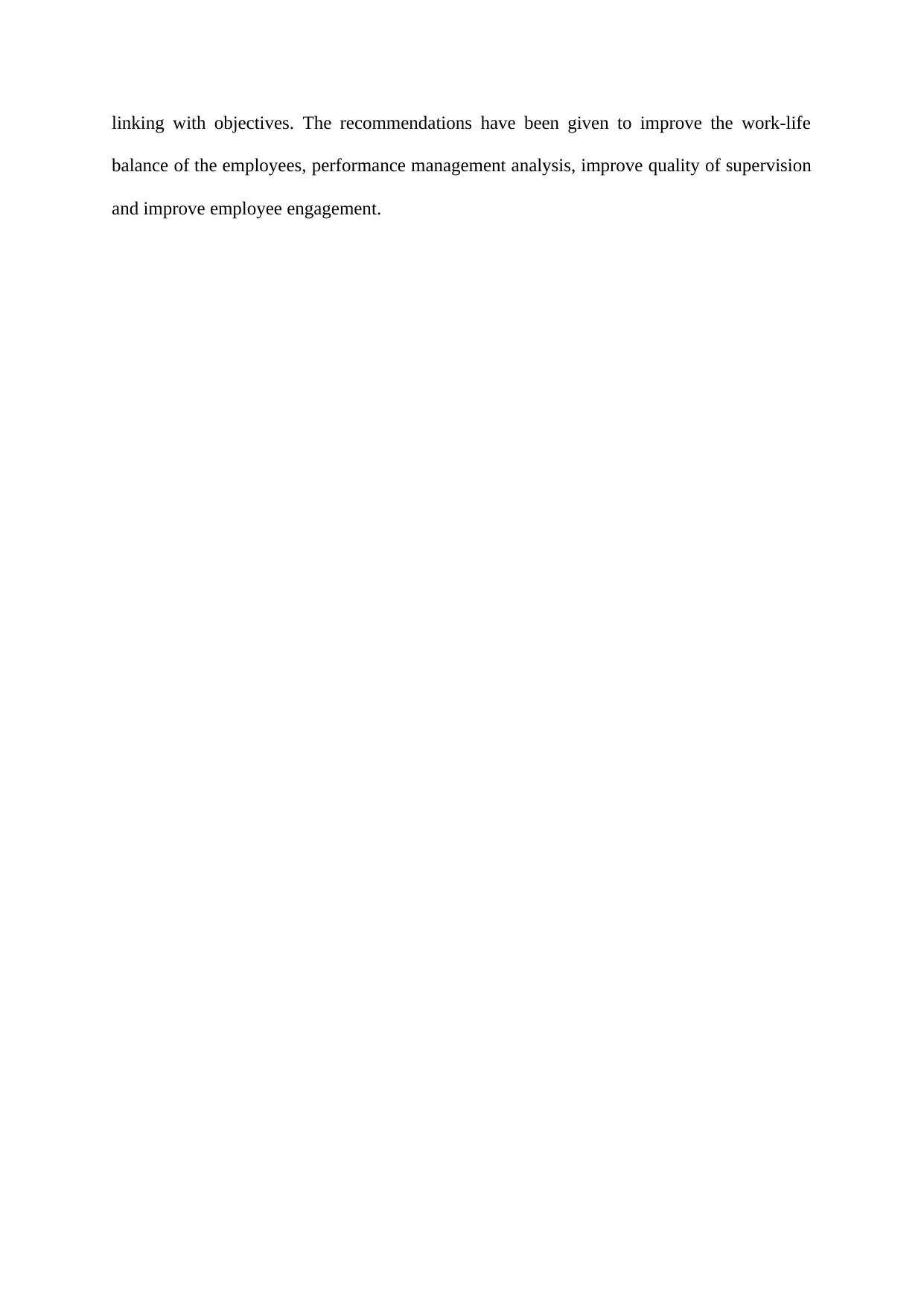
linking with objectives. The recommendations have been given to improve the work-life
balance of the employees, performance management analysis, improve quality of supervision
and improve employee engagement.
balance of the employees, performance management analysis, improve quality of supervision
and improve employee engagement.
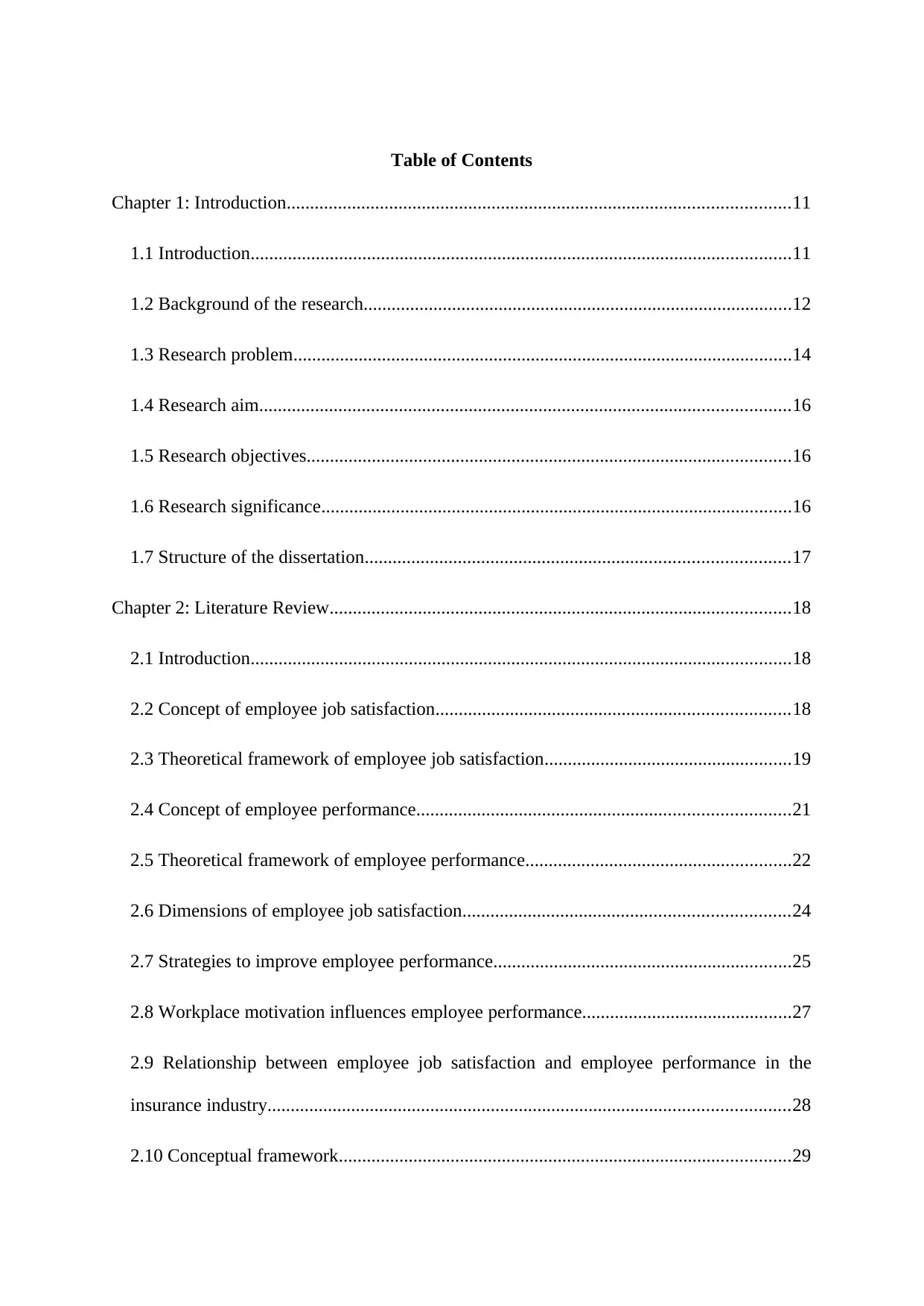
Table of Contents
Chapter 1: Introduction............................................................................................................11
1.1 Introduction....................................................................................................................11
1.2 Background of the research............................................................................................12
1.3 Research problem...........................................................................................................14
1.4 Research aim..................................................................................................................16
1.5 Research objectives........................................................................................................16
1.6 Research significance.....................................................................................................16
1.7 Structure of the dissertation...........................................................................................17
Chapter 2: Literature Review...................................................................................................18
2.1 Introduction....................................................................................................................18
2.2 Concept of employee job satisfaction............................................................................18
2.3 Theoretical framework of employee job satisfaction.....................................................19
2.4 Concept of employee performance................................................................................21
2.5 Theoretical framework of employee performance.........................................................22
2.6 Dimensions of employee job satisfaction......................................................................24
2.7 Strategies to improve employee performance................................................................25
2.8 Workplace motivation influences employee performance.............................................27
2.9 Relationship between employee job satisfaction and employee performance in the
insurance industry................................................................................................................28
2.10 Conceptual framework.................................................................................................29
Chapter 1: Introduction............................................................................................................11
1.1 Introduction....................................................................................................................11
1.2 Background of the research............................................................................................12
1.3 Research problem...........................................................................................................14
1.4 Research aim..................................................................................................................16
1.5 Research objectives........................................................................................................16
1.6 Research significance.....................................................................................................16
1.7 Structure of the dissertation...........................................................................................17
Chapter 2: Literature Review...................................................................................................18
2.1 Introduction....................................................................................................................18
2.2 Concept of employee job satisfaction............................................................................18
2.3 Theoretical framework of employee job satisfaction.....................................................19
2.4 Concept of employee performance................................................................................21
2.5 Theoretical framework of employee performance.........................................................22
2.6 Dimensions of employee job satisfaction......................................................................24
2.7 Strategies to improve employee performance................................................................25
2.8 Workplace motivation influences employee performance.............................................27
2.9 Relationship between employee job satisfaction and employee performance in the
insurance industry................................................................................................................28
2.10 Conceptual framework.................................................................................................29
⊘ This is a preview!⊘
Do you want full access?
Subscribe today to unlock all pages.

Trusted by 1+ million students worldwide
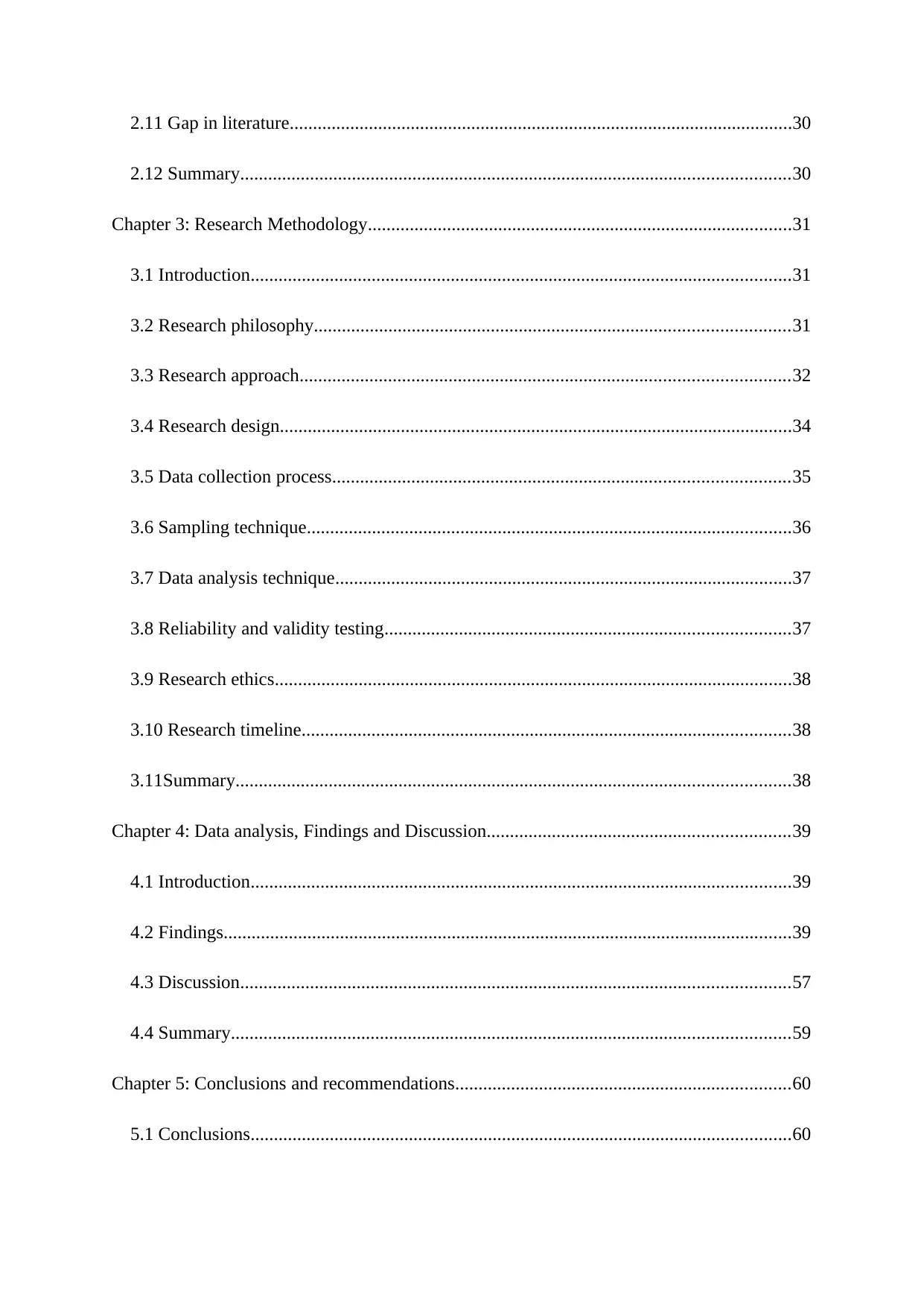
2.11 Gap in literature............................................................................................................30
2.12 Summary......................................................................................................................30
Chapter 3: Research Methodology...........................................................................................31
3.1 Introduction....................................................................................................................31
3.2 Research philosophy......................................................................................................31
3.3 Research approach.........................................................................................................32
3.4 Research design..............................................................................................................34
3.5 Data collection process..................................................................................................35
3.6 Sampling technique........................................................................................................36
3.7 Data analysis technique..................................................................................................37
3.8 Reliability and validity testing.......................................................................................37
3.9 Research ethics...............................................................................................................38
3.10 Research timeline.........................................................................................................38
3.11Summary.......................................................................................................................38
Chapter 4: Data analysis, Findings and Discussion.................................................................39
4.1 Introduction....................................................................................................................39
4.2 Findings..........................................................................................................................39
4.3 Discussion......................................................................................................................57
4.4 Summary........................................................................................................................59
Chapter 5: Conclusions and recommendations........................................................................60
5.1 Conclusions....................................................................................................................60
2.12 Summary......................................................................................................................30
Chapter 3: Research Methodology...........................................................................................31
3.1 Introduction....................................................................................................................31
3.2 Research philosophy......................................................................................................31
3.3 Research approach.........................................................................................................32
3.4 Research design..............................................................................................................34
3.5 Data collection process..................................................................................................35
3.6 Sampling technique........................................................................................................36
3.7 Data analysis technique..................................................................................................37
3.8 Reliability and validity testing.......................................................................................37
3.9 Research ethics...............................................................................................................38
3.10 Research timeline.........................................................................................................38
3.11Summary.......................................................................................................................38
Chapter 4: Data analysis, Findings and Discussion.................................................................39
4.1 Introduction....................................................................................................................39
4.2 Findings..........................................................................................................................39
4.3 Discussion......................................................................................................................57
4.4 Summary........................................................................................................................59
Chapter 5: Conclusions and recommendations........................................................................60
5.1 Conclusions....................................................................................................................60
Paraphrase This Document
Need a fresh take? Get an instant paraphrase of this document with our AI Paraphraser
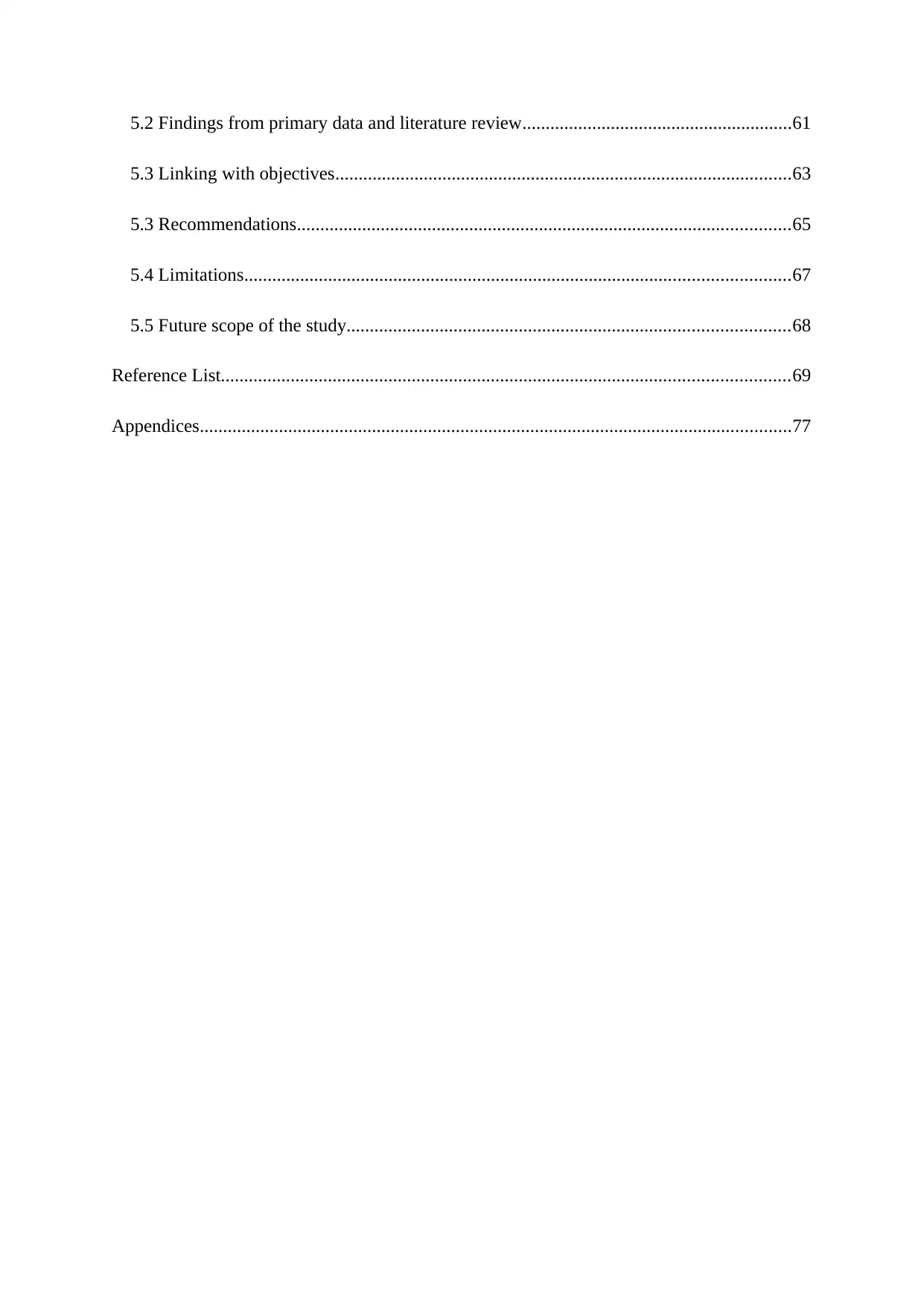
5.2 Findings from primary data and literature review..........................................................61
5.3 Linking with objectives..................................................................................................63
5.3 Recommendations..........................................................................................................65
5.4 Limitations.....................................................................................................................67
5.5 Future scope of the study...............................................................................................68
Reference List..........................................................................................................................69
Appendices...............................................................................................................................77
5.3 Linking with objectives..................................................................................................63
5.3 Recommendations..........................................................................................................65
5.4 Limitations.....................................................................................................................67
5.5 Future scope of the study...............................................................................................68
Reference List..........................................................................................................................69
Appendices...............................................................................................................................77
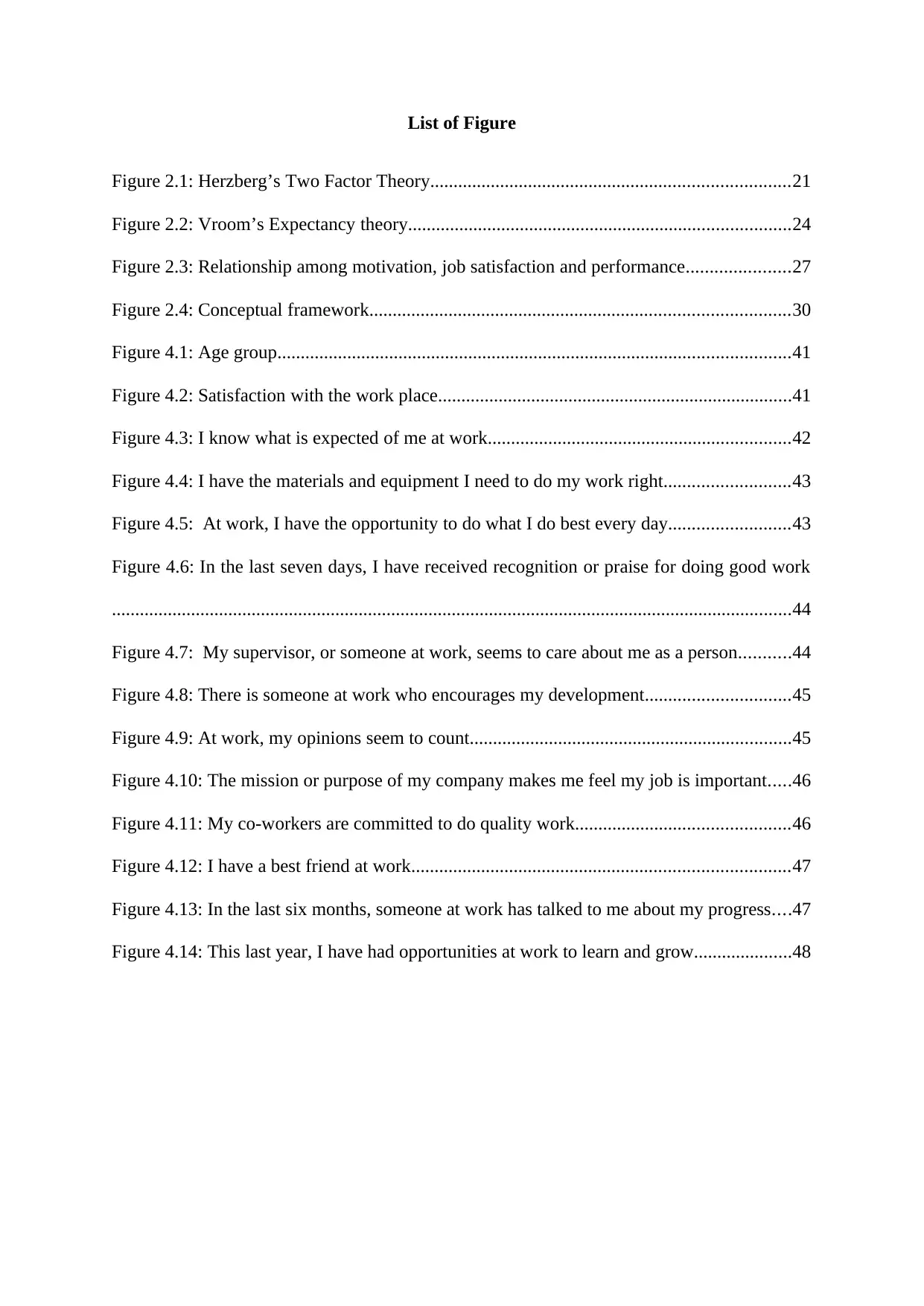
List of Figure
Figure 2.1: Herzberg’s Two Factor Theory.............................................................................21
Figure 2.2: Vroom’s Expectancy theory..................................................................................24
Figure 2.3: Relationship among motivation, job satisfaction and performance......................27
Figure 2.4: Conceptual framework..........................................................................................30
Figure 4.1: Age group..............................................................................................................41
Figure 4.2: Satisfaction with the work place............................................................................41
Figure 4.3: I know what is expected of me at work.................................................................42
Figure 4.4: I have the materials and equipment I need to do my work right...........................43
Figure 4.5: At work, I have the opportunity to do what I do best every day..........................43
Figure 4.6: In the last seven days, I have received recognition or praise for doing good work
..................................................................................................................................................44
Figure 4.7: My supervisor, or someone at work, seems to care about me as a person...........44
Figure 4.8: There is someone at work who encourages my development...............................45
Figure 4.9: At work, my opinions seem to count.....................................................................45
Figure 4.10: The mission or purpose of my company makes me feel my job is important.....46
Figure 4.11: My co-workers are committed to do quality work..............................................46
Figure 4.12: I have a best friend at work.................................................................................47
Figure 4.13: In the last six months, someone at work has talked to me about my progress....47
Figure 4.14: This last year, I have had opportunities at work to learn and grow.....................48
Figure 2.1: Herzberg’s Two Factor Theory.............................................................................21
Figure 2.2: Vroom’s Expectancy theory..................................................................................24
Figure 2.3: Relationship among motivation, job satisfaction and performance......................27
Figure 2.4: Conceptual framework..........................................................................................30
Figure 4.1: Age group..............................................................................................................41
Figure 4.2: Satisfaction with the work place............................................................................41
Figure 4.3: I know what is expected of me at work.................................................................42
Figure 4.4: I have the materials and equipment I need to do my work right...........................43
Figure 4.5: At work, I have the opportunity to do what I do best every day..........................43
Figure 4.6: In the last seven days, I have received recognition or praise for doing good work
..................................................................................................................................................44
Figure 4.7: My supervisor, or someone at work, seems to care about me as a person...........44
Figure 4.8: There is someone at work who encourages my development...............................45
Figure 4.9: At work, my opinions seem to count.....................................................................45
Figure 4.10: The mission or purpose of my company makes me feel my job is important.....46
Figure 4.11: My co-workers are committed to do quality work..............................................46
Figure 4.12: I have a best friend at work.................................................................................47
Figure 4.13: In the last six months, someone at work has talked to me about my progress....47
Figure 4.14: This last year, I have had opportunities at work to learn and grow.....................48
⊘ This is a preview!⊘
Do you want full access?
Subscribe today to unlock all pages.

Trusted by 1+ million students worldwide
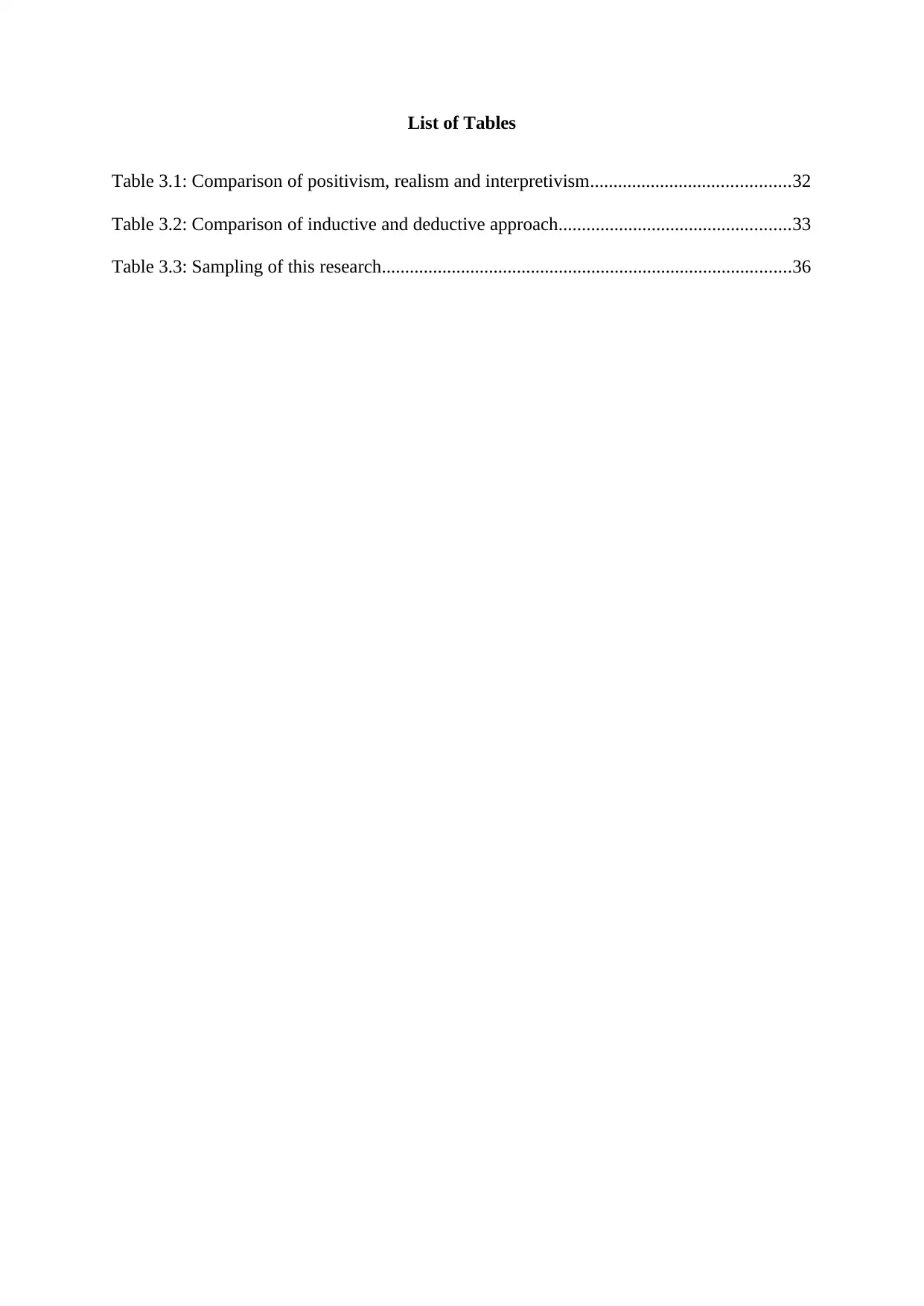
List of Tables
Table 3.1: Comparison of positivism, realism and interpretivism...........................................32
Table 3.2: Comparison of inductive and deductive approach..................................................33
Table 3.3: Sampling of this research........................................................................................36
Table 3.1: Comparison of positivism, realism and interpretivism...........................................32
Table 3.2: Comparison of inductive and deductive approach..................................................33
Table 3.3: Sampling of this research........................................................................................36
Paraphrase This Document
Need a fresh take? Get an instant paraphrase of this document with our AI Paraphraser
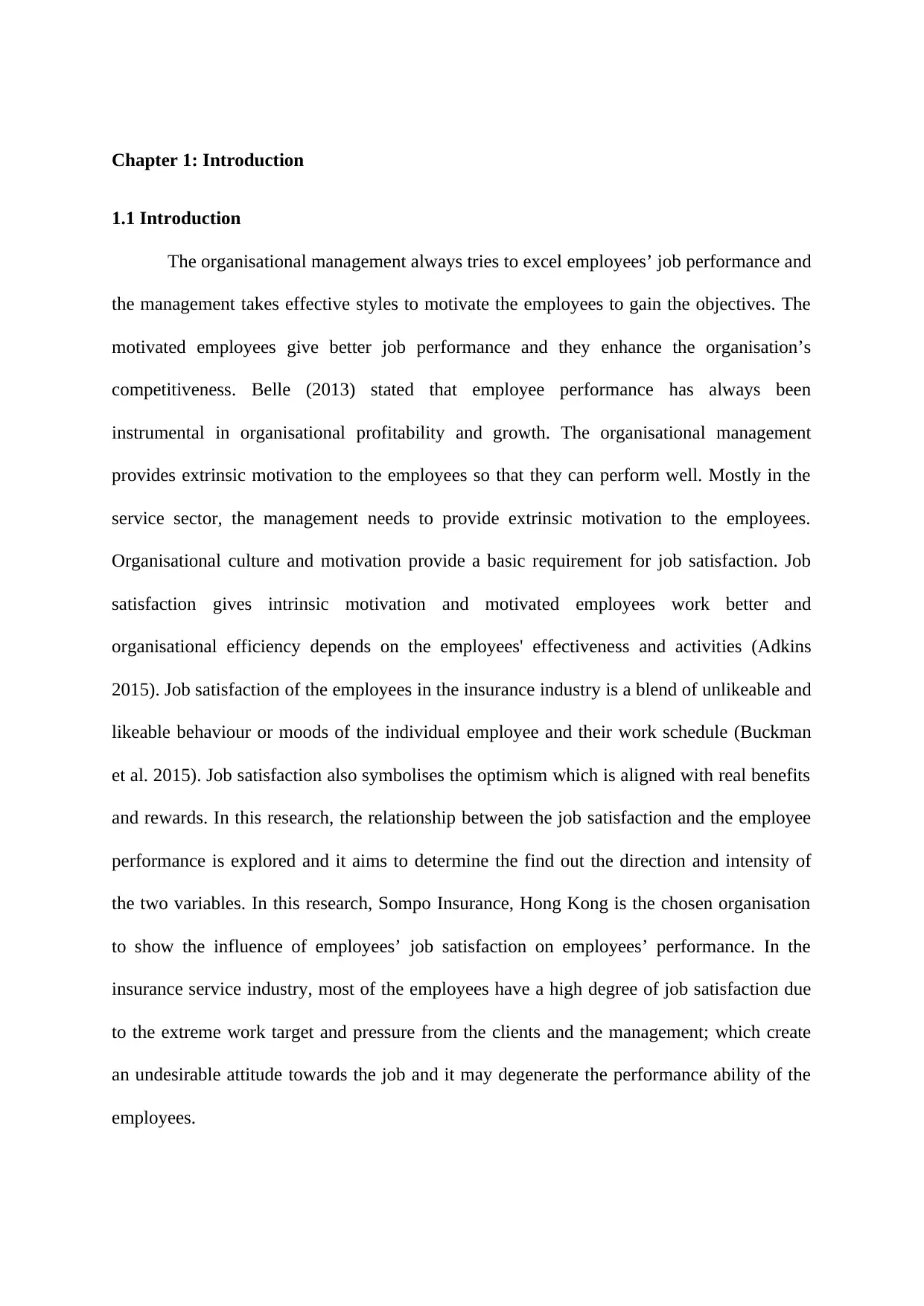
Chapter 1: Introduction
1.1 Introduction
The organisational management always tries to excel employees’ job performance and
the management takes effective styles to motivate the employees to gain the objectives. The
motivated employees give better job performance and they enhance the organisation’s
competitiveness. Belle (2013) stated that employee performance has always been
instrumental in organisational profitability and growth. The organisational management
provides extrinsic motivation to the employees so that they can perform well. Mostly in the
service sector, the management needs to provide extrinsic motivation to the employees.
Organisational culture and motivation provide a basic requirement for job satisfaction. Job
satisfaction gives intrinsic motivation and motivated employees work better and
organisational efficiency depends on the employees' effectiveness and activities (Adkins
2015). Job satisfaction of the employees in the insurance industry is a blend of unlikeable and
likeable behaviour or moods of the individual employee and their work schedule (Buckman
et al. 2015). Job satisfaction also symbolises the optimism which is aligned with real benefits
and rewards. In this research, the relationship between the job satisfaction and the employee
performance is explored and it aims to determine the find out the direction and intensity of
the two variables. In this research, Sompo Insurance, Hong Kong is the chosen organisation
to show the influence of employees’ job satisfaction on employees’ performance. In the
insurance service industry, most of the employees have a high degree of job satisfaction due
to the extreme work target and pressure from the clients and the management; which create
an undesirable attitude towards the job and it may degenerate the performance ability of the
employees.
1.1 Introduction
The organisational management always tries to excel employees’ job performance and
the management takes effective styles to motivate the employees to gain the objectives. The
motivated employees give better job performance and they enhance the organisation’s
competitiveness. Belle (2013) stated that employee performance has always been
instrumental in organisational profitability and growth. The organisational management
provides extrinsic motivation to the employees so that they can perform well. Mostly in the
service sector, the management needs to provide extrinsic motivation to the employees.
Organisational culture and motivation provide a basic requirement for job satisfaction. Job
satisfaction gives intrinsic motivation and motivated employees work better and
organisational efficiency depends on the employees' effectiveness and activities (Adkins
2015). Job satisfaction of the employees in the insurance industry is a blend of unlikeable and
likeable behaviour or moods of the individual employee and their work schedule (Buckman
et al. 2015). Job satisfaction also symbolises the optimism which is aligned with real benefits
and rewards. In this research, the relationship between the job satisfaction and the employee
performance is explored and it aims to determine the find out the direction and intensity of
the two variables. In this research, Sompo Insurance, Hong Kong is the chosen organisation
to show the influence of employees’ job satisfaction on employees’ performance. In the
insurance service industry, most of the employees have a high degree of job satisfaction due
to the extreme work target and pressure from the clients and the management; which create
an undesirable attitude towards the job and it may degenerate the performance ability of the
employees.
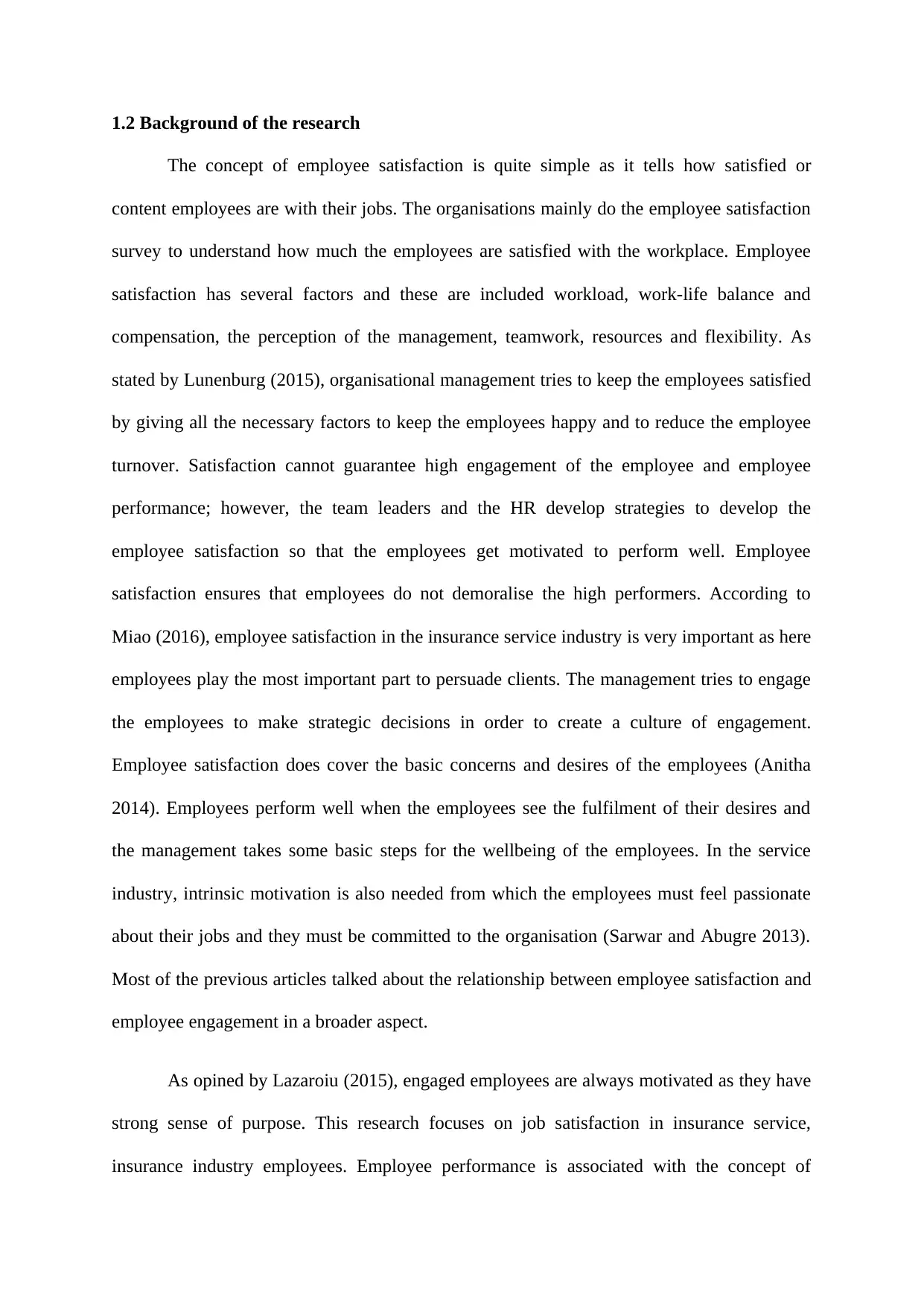
1.2 Background of the research
The concept of employee satisfaction is quite simple as it tells how satisfied or
content employees are with their jobs. The organisations mainly do the employee satisfaction
survey to understand how much the employees are satisfied with the workplace. Employee
satisfaction has several factors and these are included workload, work-life balance and
compensation, the perception of the management, teamwork, resources and flexibility. As
stated by Lunenburg (2015), organisational management tries to keep the employees satisfied
by giving all the necessary factors to keep the employees happy and to reduce the employee
turnover. Satisfaction cannot guarantee high engagement of the employee and employee
performance; however, the team leaders and the HR develop strategies to develop the
employee satisfaction so that the employees get motivated to perform well. Employee
satisfaction ensures that employees do not demoralise the high performers. According to
Miao (2016), employee satisfaction in the insurance service industry is very important as here
employees play the most important part to persuade clients. The management tries to engage
the employees to make strategic decisions in order to create a culture of engagement.
Employee satisfaction does cover the basic concerns and desires of the employees (Anitha
2014). Employees perform well when the employees see the fulfilment of their desires and
the management takes some basic steps for the wellbeing of the employees. In the service
industry, intrinsic motivation is also needed from which the employees must feel passionate
about their jobs and they must be committed to the organisation (Sarwar and Abugre 2013).
Most of the previous articles talked about the relationship between employee satisfaction and
employee engagement in a broader aspect.
As opined by Lazaroiu (2015), engaged employees are always motivated as they have
strong sense of purpose. This research focuses on job satisfaction in insurance service,
insurance industry employees. Employee performance is associated with the concept of
The concept of employee satisfaction is quite simple as it tells how satisfied or
content employees are with their jobs. The organisations mainly do the employee satisfaction
survey to understand how much the employees are satisfied with the workplace. Employee
satisfaction has several factors and these are included workload, work-life balance and
compensation, the perception of the management, teamwork, resources and flexibility. As
stated by Lunenburg (2015), organisational management tries to keep the employees satisfied
by giving all the necessary factors to keep the employees happy and to reduce the employee
turnover. Satisfaction cannot guarantee high engagement of the employee and employee
performance; however, the team leaders and the HR develop strategies to develop the
employee satisfaction so that the employees get motivated to perform well. Employee
satisfaction ensures that employees do not demoralise the high performers. According to
Miao (2016), employee satisfaction in the insurance service industry is very important as here
employees play the most important part to persuade clients. The management tries to engage
the employees to make strategic decisions in order to create a culture of engagement.
Employee satisfaction does cover the basic concerns and desires of the employees (Anitha
2014). Employees perform well when the employees see the fulfilment of their desires and
the management takes some basic steps for the wellbeing of the employees. In the service
industry, intrinsic motivation is also needed from which the employees must feel passionate
about their jobs and they must be committed to the organisation (Sarwar and Abugre 2013).
Most of the previous articles talked about the relationship between employee satisfaction and
employee engagement in a broader aspect.
As opined by Lazaroiu (2015), engaged employees are always motivated as they have
strong sense of purpose. This research focuses on job satisfaction in insurance service,
insurance industry employees. Employee performance is associated with the concept of
⊘ This is a preview!⊘
Do you want full access?
Subscribe today to unlock all pages.

Trusted by 1+ million students worldwide
1 out of 83
Related Documents
Your All-in-One AI-Powered Toolkit for Academic Success.
+13062052269
info@desklib.com
Available 24*7 on WhatsApp / Email
![[object Object]](/_next/static/media/star-bottom.7253800d.svg)
Unlock your academic potential
Copyright © 2020–2025 A2Z Services. All Rights Reserved. Developed and managed by ZUCOL.





